(RECIPROCAL) POLAR OF A CURVE
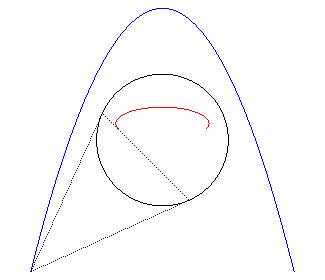
| next curve | previous curve | 2D curves | 3D curves | surfaces | fractals | polyhedra |
(RECIPROCAL) POLAR OF A CURVE

| Other name: dual curve. |
| The polar with respect to the circle with centre O
and radius a of the point M0
(x0,
y0)
is the line with equation If M0 is the current point on |
1) Reminder on poles and polars.
Two points M and M0
are said to be conjugates of one another with respect to a circle
(C) with centre O and radius a when the circle with
diameter [M0M] is orthogonal
to (C), i.e. ;
this comes from the fact that when the line (M0M)
cuts the circle at A and B, M and M0
are harmonic conjugates with respect to [AB].
The polar of a point M0
with respect to (C) is then the locus of the conjugates M
of the point M0 with respect to
the circle, and therefore defined by the relation ;
it is the line orthogonal to the line (OM0)
passing by the inverse of M0 with
respect to (C); it is also the radical axis of the circle (C)
and of the circle with diameter [OM0].
When M0 is outside (C), it
is the line joining the contact points of the tangents to the circle that
pass by M0. Conversely, a line is
the polar of a unique point, called its pole.
Despite its relation to the inversion, the natural space
of this transformation is not the conformal plane, but the projective plane:
the polar of the point O then is the line at infinity, and the polar
of a point at infinity is the line passing by O and perpendicular
to the direction of the point.
2) Definition of the polar of a curve.
The polar of a plane curve
with respect to a circle (C) (the "directrix (C)") is the
envelope of the polars of the points
with respect to (C); it can be proved that it also is the set of
the poles of the tangents to
with respect to (C).
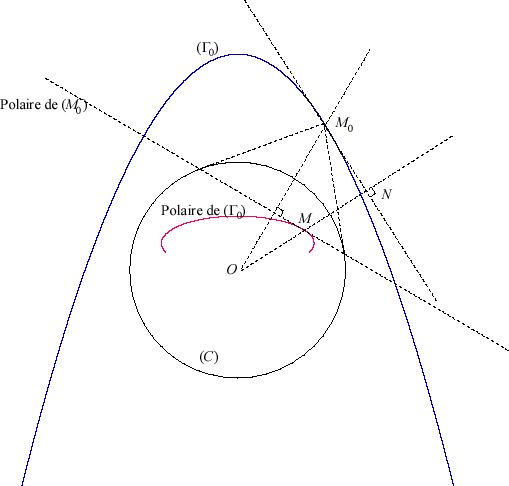 |
The characteristic point of the polar of M0
is also the pole of the tangent to |
This transformation, called reciprocal polar transformation is an involution, that is, the polar of the polar is equal to the initial curve.
The inverse of the polar with respect to the same circle is none other than the pedal of the initial curve; we can sum this up with this diagram:
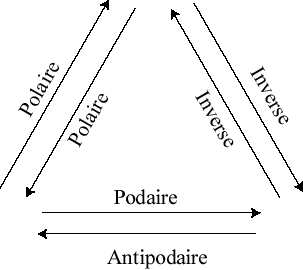
See two examples opposite: |
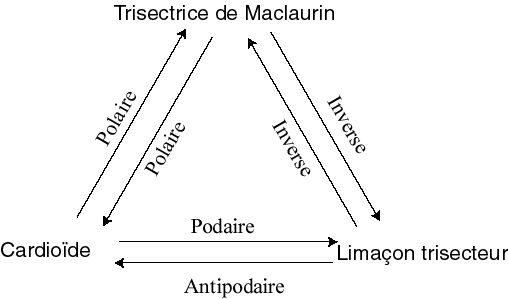 |
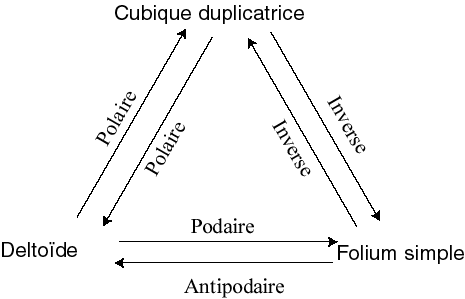 |
The polar of an algebraic curve is an algebraic curve the degree of which is equal to the class of the initial curve (i.e. the degree of the tangential equation).
Examples:
| initial curve | position of the centre of (C) with respect to the initial curve | position of the centre of (C) with respect to the polar | polar |
| line (polar of the point) | outside of the line | different from the point | point (pole of the line) |
| conic | conic | ||
| conic | focus | circle | |
| conic | inside the conic (i.e. in a domain containing a focus) | ellipse | |
| conic | outside the conic | hyperbola | |
| conic | on the conic | parabola | |
| cardioid | cuspidal point | focus at the 8/9 of the segment line joining the double point to the summit. | Tschirnhausen cubic |
| cardioid | centre of the conchoidal circle | focus | Maclaurin trisectrix |
| deltoid | centre | vertex | duplicatrix cubic |
| astroid | centre | centre | cross curve |
| centred cycloid | centre | centre | epispiral |
| sinusoidal
spiral with parameter |
centre | centre | sinusoidal
spiral with parameter |
See the 3D
generalisation of these notions.
| next curve | previous curve | 2D curves | 3D curves | surfaces | fractals | polyhedra |
© Robert FERRÉOL 2017